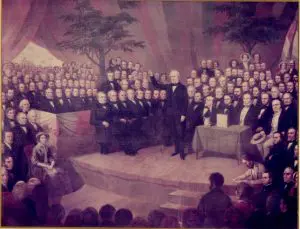The Lazzaroni

Given that the Inauguration of the Dudley Observatory took place right after the AAAS convention, it’s not surprising that many of the attendees were scientists. However, some of the names of the list of attendees stand out: Alexander Dallas Bache, superintendent of the foremost scientific institution in America at the time, the US Costal Survey. Benjamin Osgood Peirce, influential mathematician at Harvard. Louis Agassiz, internationally famous naturalist. Joseph Henry, pioneering electrical engineer and the first director of the Smithsonian. Wolcott Gibbs, prominent chemist, soon to be at Harvard.
These men were some of the leading scientists in America at the time. These names, along with other attendees like James Dwight Dana, James Hall, and of course Benjamin Gould, make up an impressive list of some of the best and brightest. But all these names have another thing in common: they were part of a group known as the Lazzaroni.
On one hand, the Lazzaroni were just a group of like-minded colleagues in the field of science who agreed to get together during conventions to “eat an outrageously good dinner together”. On the other hand, the Lazzaroni were a clique of influential scientists who all agreed that American science needed to become more professional along the lines of German science.
The name “Lazzaroni” sounds like a pasta, but was an Italian term for beggar, and it was probably an ironic reference to the poor state of science on early 19th century America. As Benjamin Gould discovered when he returned from Europe, American science simply didn’t have the tools that European scientists had, nor did they have the resources to build the tools. America needed scientific institutions if it was going to compete.

The Lazzaroni, in between meals and drinking, agreed that building these institutions should be a priority, that the right sorts of people should be recruited to lead them. Probably their greatest achievement was the creation of the National Academy of Sciences, founded by congress in 1863 to act as scientific advisers to the government. They also backed a plan to create a university and an observatory in Albany, although not at the same time. That takes a little explaining.
As I mention previously, it was James Armsby who originally suggested that an observatory be added on to plans for a world class university to be built in Albany. While Agassiz supported the idea, the rest of the Lazzaroni were opposed to spending the money. America had two world class refracting telescopes at that point; one in Harvard and one in Cincinnati that was inactive as Ormsby Mitchell toured the country raising money for staff. Adding a third didn’t seem to advance American science much while taking away resources that could be better spent.
The plan for a university died when the state legislature would not fund it, but thanks to the efforts of Mtichell and Armsby the observatory found private funding from donors like Blandina Dudley. At that point, the Lazzaroni started to come around. They worked out a deal with the Armsby that would shape the purpose of the new observatory: if Dudley would purchase instruments for very careful measurements of stellar objects, like a heliometer and a transit circle (more on these later), then the Lazzoroni would throw their considerable weight behind the project.
In essence, the Lazzaroni wanted a specialized observatory that would complement the work that the Costal Survey was doing. In return, Dudley got a three of the biggest names in American science on their board: Alexander Bache, Joseph Henry and Benjamin Peirce. And one other, not quite so big name: Benjamin Gould.
It’s tempting (and fun) to make the Lazzaroni into some kind of shadowy conspiracy. The “professionalization of science” was a profound shift in American thought, but it is maddeningly vague and hard to define exactly what happened. The Lazzaroni give historians something tangible to point to: a group of elite white men in smoke-filled back rooms conspiring to take over American science and fill it with the “right sort” of people (See? Fun.)
But it’s easy to make too much of them. Here at Dudley, they failed repeatedly. They could not get the state to support a new university, and they eventually lost their influence over the observatory. Still, their deal with Armsby gave Dudley it’s trajectory as something more than a meeting place for local stargazers. Dudley would become a world class observatory doing careful measurements of the heaves, but not until the Lazzaroni were kicked out of the place.
